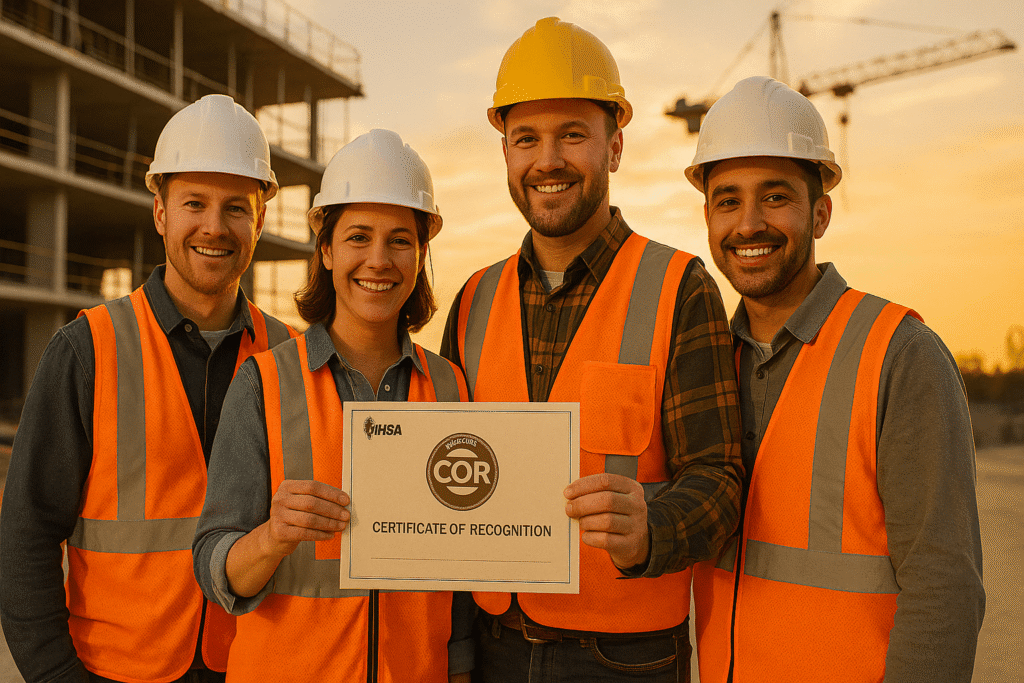Complete Guide to COR Certification Ontario: Everything Construction Companies Need to Know in 2025
/If you’re running a construction company in Ontario, you’ve likely heard about COR certification—and maybe wondered if it’s worth the investment. The short answer? Absolutely. Certificate of Recognition (COR) certification isn’t just a nice-to-have credential; it’s becoming essential for accessing major contracts, reducing insurance costs, and proving your commitment to workplace safety.
Understanding Cor Certification Ontario is essential to securing your competitive edge in the construction market.
This comprehensive guide breaks down everything Ontario construction companies need to know about COR certification, from the application process to maintaining your certification year after year.
What is COR Certification in Ontario?
Certificate of Recognition (COR) is a voluntary certification program that recognizes employers who have developed health and safety management systems that meet established standards. In Ontario, the Infrastructure Health & Safety Association (IHSA) administers the COR 2020 program, which replaced the previous COR system to align with current safety standards and regulations.
Understanding the significance of Cor Certification Ontario is crucial for any construction company aiming to thrive in the competitive market. This includes grasping how Cor Certification Ontario can enhance your operational standards.
Think of COR certification as your company’s safety report card. It demonstrates to clients, insurance providers, and regulatory bodies that you’ve implemented comprehensive safety practices that go beyond basic compliance. For construction companies, this certification opens doors to larger projects and provides tangible business benefits.
The COR safety program evaluates your Occupational Health and Safety Management System (OHSMS) across multiple elements, ensuring your company has robust procedures for hazard identification, incident investigation, training, and continuous improvement.
In Ontario, having Cor Certification Ontario is a significant asset for construction companies looking to attract high-profile clients.
Cor Certification Ontario is a gateway to larger contracts and collaborative relationships in the construction industry.
Why Ontario Construction Companies Need COR Certification Ontario
Acquiring Cor Certification Ontario can help your company qualify for insurance benefits that provide essential financial relief.
Access to Major Contracts
With Cor Certification Ontario, your construction firm can better position itself against competition that lacks this certification.
Many large construction projects, municipal contracts, and industrial clients now require COR certification as a prerequisite for bidding. Without this credential, you’re automatically excluded from these lucrative opportunities. General contractors increasingly demand that their subcontractors hold COR certification to reduce project risk and meet their own safety requirements.
Furthermore, Cor Certification Ontario has been shown to correlate with reduced workplace incidents, leading to overall lower costs.
Insurance and WSIB Benefits
COR-certified companies often receive discounts on commercial insurance premiums and may qualify for WSIB experience rating benefits. These savings can quickly offset the initial investment in certification. Insurance providers view COR certification as evidence of proactive risk management, translating to lower claims and reduced premiums.
Competitive Advantage
In Ontario’s competitive construction market, COR certification sets you apart from competitors who haven’t made this safety investment. It signals to potential clients that you’re serious about protecting workers and managing project risks effectively.
Reduced Incidents and Costs
Companies with strong safety management systems typically experience fewer workplace incidents, resulting in lower direct and indirect costs. This includes reduced lost-time claims, lower investigation costs, and improved productivity from a safer, more confident workforce.
IHSA COR 2020: The Current Standard
The IHSA COR 2020 program represents the latest evolution of Ontario’s COR certification. Launched to align with modern safety management principles, COR 2020 focuses on leadership commitment, worker participation, and continuous improvement.
Key Features of COR 2020
Leadership and Commitment: Senior management must demonstrate visible commitment to safety through policy development, resource allocation, and active participation in safety activities.
Worker Participation: The program emphasizes meaningful worker involvement in hazard identification, incident investigation, and safety program development.
Risk Assessment: Companies must implement systematic approaches to identifying, assessing, and controlling workplace hazards specific to their operations.
Training and Competency: Structured training programs ensure all workers have the knowledge and skills needed to work safely.
Documentation and Record Keeping: Comprehensive documentation requirements ensure your safety management system is measurable and auditable.
Step-by-Step COR Certification Process
Step 1: Register with IHSA

Begin by registering your company with IHSA and expressing interest in COR 2020 certification. IHSA will provide initial guidance and access to required resources, including audit tools and documentation templates.
Step 2: Complete Required Training
Both management and designated internal auditors must complete IHSA-approved training programs. Management training covers leadership responsibilities, while internal auditor training prepares personnel to evaluate your safety management system objectively.
Step 3: Develop Your Safety Management System
Create or enhance your Occupational Health and Safety Management System to meet COR 2020 standards. This includes developing policies, procedures, forms, and training programs that address all required elements.
Step 4: Implement and Document
Implement your safety management system across all operations for a minimum of 12 months. During this period, you must document evidence of system effectiveness, including training records, hazard assessments, incident investigations, and corrective actions.
Step 5: Conduct Internal Audit
After 12 months of implementation, conduct a comprehensive internal audit using IHSA audit tools. This self-assessment identifies gaps and ensures your system meets certification requirements before the external audit.
Step 6: Schedule External Audit
Once your internal audit confirms readiness, schedule an external audit with an IHSA-approved auditor. This independent assessment determines whether your safety management system meets COR 2020 standards.
Step 7: Address Audit Findings
If the external audit identifies deficiencies, you’ll have a specified timeframe to address these issues and provide evidence of corrective actions. Minor deficiencies can typically be resolved through documentation, while major findings may require system modifications.
Step 8: Receive Certification
Upon successful completion of the external audit and resolution of any findings, IHSA awards your COR 2020 certification, valid for three years.
COR Certification Requirements and Documentation

Essential Documentation Components
Safety Policy: A comprehensive policy signed by senior management outlining your company’s commitment to workplace safety and health.
Hazard Assessment and Control: Documented processes for identifying, assessing, and controlling workplace hazards, including job safety analyses and risk matrices.
Training Records: Complete records of safety training provided to all personnel, including orientation, job-specific training, and refresher sessions.
Incident Reporting and Investigation: Procedures and records for reporting, investigating, and analyzing workplace incidents, near-misses, and property damage events.
Emergency Response Plans: Site-specific emergency procedures covering potential scenarios such as medical emergencies, fires, and severe weather events.
Inspection and Maintenance Records: Evidence of regular workplace inspections, equipment maintenance, and corrective action implementation.
Digital vs. Paper Documentation
While traditional paper-based systems remain acceptable, many Ontario construction companies are transitioning to digital safety management platforms. Digital systems offer advantages including real-time data access, automated reminders, and simplified audit preparation.
Timeline and Costs for COR Certification
Typical Timeline
The COR certification process typically requires 18-24 months from start to finish:
- Months 1-3: Registration, training completion, and initial system development
- Months 4-15: System implementation and evidence collection
- Months 16-18: Internal audit, external audit scheduling, and certification completion
- Months 19-24: Potential additional time for addressing audit findings.
Investment Considerations
COR certification costs vary based on company size, existing safety program maturity, and chosen implementation approach:
Training Costs: IHSA training fees for management and internal auditors typically range from $1,500-$3,000 per company.
System Development: Companies developing systems internally may invest 100-200 hours of management time, while those hiring consultants can expect fees ranging from $8,000-$25,000.
External Audit Fees: IHSA-approved auditors charge approximately $1,500-$4,000 depending on company size and complexity.
Ongoing Maintenance: Annual system maintenance, including training updates and documentation reviews, typically costs $2,000-$5,000.
Common COR Audit Challenges and How to Avoid Them
Documentation Gaps
Challenge: Insufficient evidence of system implementation and effectiveness. Solution: Maintain consistent documentation throughout the 12-month implementation period. Use checklists and regular reviews to ensure completeness.
Worker Participation
Challenge: Limited evidence of meaningful worker involvement in safety activities. Solution: Establish joint health and safety committees, regular safety meetings, and worker feedback mechanisms with documented outcomes.
Management Commitment
Challenge: Lack of visible senior management involvement in safety activities. Solution: Ensure senior management participates in safety meetings, reviews incident reports, and allocates appropriate resources to safety initiatives.

Training Currency
Challenge: Outdated or incomplete training records for personnel. Solution: Implement training tracking systems with automated renewal reminders and maintain comprehensive training matrices.
Corrective Action Follow-up
Challenge: Incomplete follow-up on identified hazards and corrective actions. Solution: Establish formal corrective action tracking systems with assigned responsibilities and completion deadlines.
Maintaining Your COR Certification
COR certification requires ongoing maintenance to remain valid throughout the three-year certification period.
Annual Maintenance Requirements
System Updates: Regularly review and update safety procedures to reflect operational changes, new equipment, or regulatory updates.
Continued Training: Maintain training currency for all personnel and provide additional training as job roles or hazards change.
Performance Monitoring: Continuously monitor safety performance through metrics such as incident rates, training completion, and audit findings.
Internal Audits: Conduct periodic internal audits to ensure system effectiveness and identify improvement opportunities.
Renewal Process
Approximately six months before your certification expires, begin the renewal process by scheduling a maintenance audit with an IHSA-approved auditor. This scaled audit focuses on system changes and continuous improvement since your initial certification.
How Calibre Simplifies Your COR Journey

Navigating the COR certification process while running your construction business can feel overwhelming. That’s where Calibre Business Solutions makes the difference. We’ve guided dozens of Ontario construction companies through successful COR certification, handling the complexity so you can focus on your projects.
Our COR Certification Services
Gap Assessment: We evaluate your current safety program against COR 2020 requirements and provide a clear roadmap for certification.
System Development: Our team creates customized safety management systems that reflect your actual operations, not generic templates.
Training Coordination: We coordinate with IHSA to ensure your team completes required training on schedule.
Documentation Support: From policies to forms, we develop all necessary documentation in plain language your workers will actually use.
Audit Preparation: We conduct thorough pre-audits and prepare your team for the external assessment process.
Ongoing Maintenance: Our monthly compliance plans keep your COR certification current while managing other platform requirements like ISNetworld and ContractorCheck.
For consultation on achieving Cor Certification Ontario, reach out and let us assist you in this important journey.
With our money-back guarantee on health and safety program work and 66% repeat customer rate, you can trust that we’ll deliver results. Our clients consistently pass their COR audits because we prepare them thoroughly and tailor everything to their specific operations.
Let Calibre Business Solutions handle your safety compliance, so you can concentrate on running your business. Contact Blake at 780-832-5158 or blake@calibrebusinesssolutions.ca to discuss your COR certification needs.
FAQ Section
Q: How long does COR certification last in Ontario? A: COR 2020 certification is valid for three years from the date of issuance. Companies must undergo a maintenance audit before expiration to renew their certification.
Q: Can small construction companies with fewer than 10 employees get COR certified? A: Yes, there’s no minimum employee requirement for COR certification in Ontario. However, smaller companies may find the documentation requirements challenging without professional assistance.
Q: What’s the difference between COR and COR 2020? A: COR 2020 is the current standard that replaced the previous COR program. It emphasizes leadership commitment, worker participation, and continuous improvement while aligning with modern safety management principles.
Q: Do I need COR certification to bid on government contracts in Ontario? A: While not universally required, many municipal and provincial contracts now specify COR certification as a bidding requirement. The trend is moving toward mandatory certification for larger projects.
Thus, having Cor Certification Ontario can significantly enhance your reputation within the industry.
Ultimately, obtaining Cor Certification Ontario is a strategic business move that can yield substantial long-term benefits.
Q: Can I maintain COR certification if my company grows significantly? A: Yes, COR certification scales with company growth. You’ll need to update your safety management system to reflect new operations, additional personnel, and expanded scope of work, but certification remains valid throughout the three-year period.
Conclusion
Your commitment to workplace safety through Cor Certification Ontario demonstrates leadership in Ontario’s construction industry.
COR certification in Ontario represents more than regulatory compliance—it’s a strategic business investment that opens doors to new opportunities while protecting your most valuable asset: your workers. The IHSA COR 2020 program provides a clear framework for developing robust safety management systems that reduce incidents, lower costs, and enhance your competitive position.
While the certification process requires significant commitment, the benefits of Cor Certification Ontario far outweigh the investment.
The key to successful COR certification lies in thorough preparation, systematic implementation, and ongoing maintenance. Whether you choose to navigate this process independently or partner with experienced consultants like Calibre Business Solutions, the important step is getting started.
Your commitment to workplace safety through COR certification demonstrates leadership in Ontario’s construction industry and positions your company for sustainable growth in an increasingly safety-conscious marketplace.




